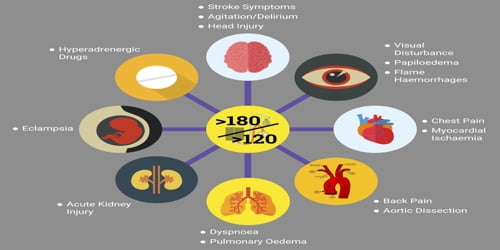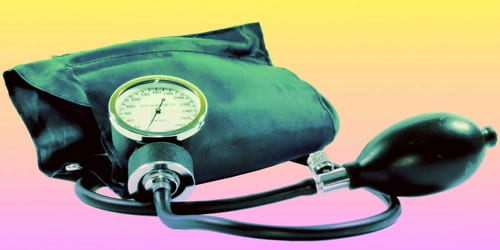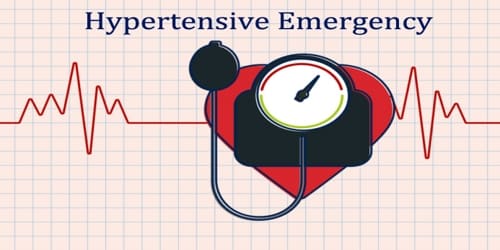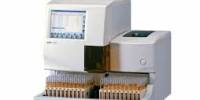Hypertensive Emergency
Definition: Hypertensive emergency means blood pressure is so high that organ damage can occur. Blood pressure must be reduced immediately to prevent imminent organ damage. It is also known as malignant hypertension.
Typically the systolic blood pressure is at least over 180 mmHg or the diastolic is over 110-120 mmHg. It can result in irreversible organ damage. In a hypertensive emergency, the blood pressure should be slowly lowered over a period of minutes to hours with an antihypertensive agent.
Organ damage associated with the hypertensive emergency may include:
- Changes in mental status, such as confusion
- Bleeding into the brain (stroke)
- Heart failure
- Chest pain (unstable angina)
- Fluid in the lungs (pulmonary edema)
- Heart attack
- Aneurysm (aortic dissection)
- Eclampsia (happens during pregnancy)
Hypertensive emergency is rare. When it does occur, it is often when hypertension goes untreated, if the patient does not take his or her blood pressure medication, or he or she has taken an over-the-counter medication that exacerbates high blood pressure.

Causes, Sign, and Symptom of Hypertensive Emergency: Many factors and causes are contributory in hypertensive crises. One main cause is the discontinuation of antihypertensive medications. Other common causes of hypertensive crises are autonomic hyperactivity, collagen-vascular diseases, drug use (particularly stimulants, especially cocaine and amphetamines and their substituted analogues), glomerulonephritis, head trauma, neoplasias, preeclampsia and eclampsia, and renovascular hypertension.
The eyes may show bleeding in the retina or an exudate. Papilledema must be present before a diagnosis of malignant hypertension can be made. The brain shows manifestations of increased pressure within the cranium, such as a headache, nausea, vomiting, and/or subarachnoid or cerebral hemorrhage. Chest pain may occur due to increased workload on the heart resulting in a mismatch in the oxygen demand and supply to the heart muscle resulting in inadequate delivery of oxygen to meet the heart muscle’s metabolic needs.
Others Sign and Symptoms of a hypertensive emergency include:
- Headache or blurred vision
- Abnormal heart rhythms
- Increasing confusion
- Seizure
- Increasing chest pain
- Increasing shortness of breath
- Altered mental status
- Swelling or edema (fluid buildup in the tissues)
Sometimes, the term hypertensive emergency is also used as a generic term, comprising both hypertensive emergency, as a specific term for a serious and urgent condition of elevated blood pressure, and hypertensive urgency, as a specific term of a less serious and less urgent condition.

Diagnosis and Treatment of Hypertensive Emergency: Hypertensive emergencies are diagnosed if there is a systolic blood pressure higher than 180 mmHg or a diastolic blood pressure higher than 120 mmHg with the presence of acute target organ damage. Hypertensive urgencies are diagnosed if there is a systolic blood pressure higher than 180 mmHg or a diastolic blood pressure higher than 120 mmHg in an otherwise stable person without clinical or laboratory evidence of acute target organ damage. These persons need intensification of their antihypertensive drug therapy.
Several classes of antihypertensive agents are recommended, with the choice depending on the cause of the hypertensive crisis, the severity of the elevation in blood pressure, and the usual blood pressure of the person before the hypertensive crisis.
In addition, non-pharmacological treatment could be considered in cases of resistant malignant hypertension due to end-stage kidney failures, such as surgical nephrectomy, laparoscopic nephrectomy, and renal artery embolization in cases of anesthesia risk.
The antihypertensive drug of choice for treating acute cerebral hemorrhage needs to be investigated by randomized clinical trials. Rapid-acting, easily titratable drugs administered intravenously such as clevidipine, nicardipine, labetalol, and urapidil are reasonable first-line drugs for treating these patients.
As a result of the use of antihypertensives, the rates of hypertensive emergencies has declined from 7% to 1% of people with high blood pressure. The 1–year survival rate has also increased. Before 1950, this survival rate was 20%, but it is now more than 90% with proper medical treatment.
Information Source:
















